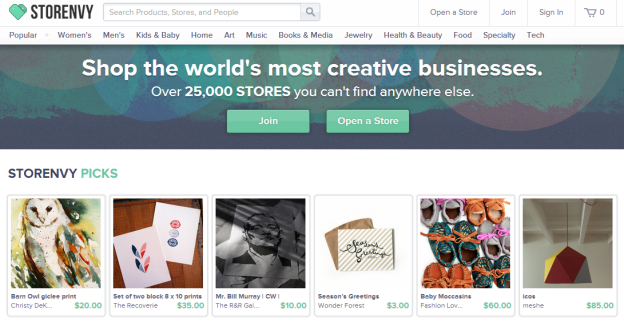
Storenvy, an e-commerce platform for independent and big box retailers alike, is shaking up its digital retailing game by pivoting into an Internet storefront. Starting today, Storenvy is aiming to establish itself as the leading Internet mall and the Amazon of niche consumer products.
Historically Storenvy has been recognized as a competitor to Shopify, Magento, and BigCartel; these are B2B, software-as-a-service business types. An entrepreneur with a product to sell but with little knowledge about building their own e-commerce site would turn to one of the above solutions for a fast way to get a site up and running with minimal hassles.
Storenvy however is shaking up the age-old B2B business model and highlighting its new marketplace. Starting today, when you visit Storenvy.com, the landing page presents a grid of products aggregated from Storenvy sellers. These are hand curated products that Storenvy’s team is publishing on the front page for now. Below that are algorithmically curated picks of the most popular products. If you dig deeper into Storenvy, you’ll find a plethora of filters and categories for shoppers to find new and creative products that you can engage with or purchase. Some of these categories can be found under its navigation bar, which organizes products by genres like “Tech,” “Art,” and “Food.”There’s really nothing you can’t find that’s sold by someone on Storenvy. Its robust search engine and social discovery portal cuts through the noise of nearly 500,000 products and 6,000 new products added weekly by users, to find the ones that would most interest you.
There are definitely some similarities between Storevny and Etsy. But what differentiates Etsy from Storenvy, as founder Jon Crawford explains, is that Etsy sells hand-crafted products and didn’t start off as a B2B ecommerce platform. Despite the differentiation, like Etsy, Storenvy is providing its network of sellers an extra distribution channel for their products to be discovered. “We think of ourselves as the Gutenberg printing press of stores, which democratizes and empowers regular people,” says Crawford.

This is just the tip of the iceberg when it comes to Strorenvy’s rebranding. Storenvy is also a social shopping destination. Users can follow stores, follow friends, comment, Like products, and even connect with the community in a public forum. You can see what your influencers and friends are discovering and purchasing in real-time through a feed on a user’s homepage called, “MyFeed,” which might convince you to make the same purchase. But there’s a secondary importance to the engagement features like commenting, Likes, and follows. Sellers can build up loyal fans and followers like influencers do on YouTube or Tumblr.
Inspired by YouTube’s strategy, Crawford eventually hopes that Storenvy celebrities will emerge from the group. “What we’re shooting for is that if you’re selling spectacular products, you could become a star much the same way that YouTube create a world where a person who’s really entertaining or talented can become a star through YouTube. We want to do the same thing for products.”
In terms of Storenvy’s direction moving forward Crawford tells me that he often draws comparisons between his company and Tumblr. Despite the WordPress, Typepad, Bloggers of the world, Tumblr decided to tread in a different direction by offering a stripped down, extremely easy to use social blogging platform that wasn’t focused on selling features to power users. Tumblr then transitioned its platform into a network for content discovery through social features. Like Tumblr, Storenvy may have started out B2B by building the infrastructure for stores and merchants from the beginning, but the team always had in mind that it was going to rebrand to the look and feel of a retail shopping experience.
“Companies like Volusion, BigCommerce, Shopify, and there are fifty or so of these companies, they’re all very similar. And they’re all in a feature war, and they’re all in a price war. We decided that it doesn’t make sense to compete on features or price. What we want to compete on is community size, critical mass, and network effects. That’s what made Tumblr a success,” Crawford explains.
While starting today the frontend marketplace has finally been launched, Storenvy of course will continue to support its e-commerce platform.
Edit: Added updated screenshots, and removed references to MyStorenvy, which was a feature that has been removed with the redesign.


